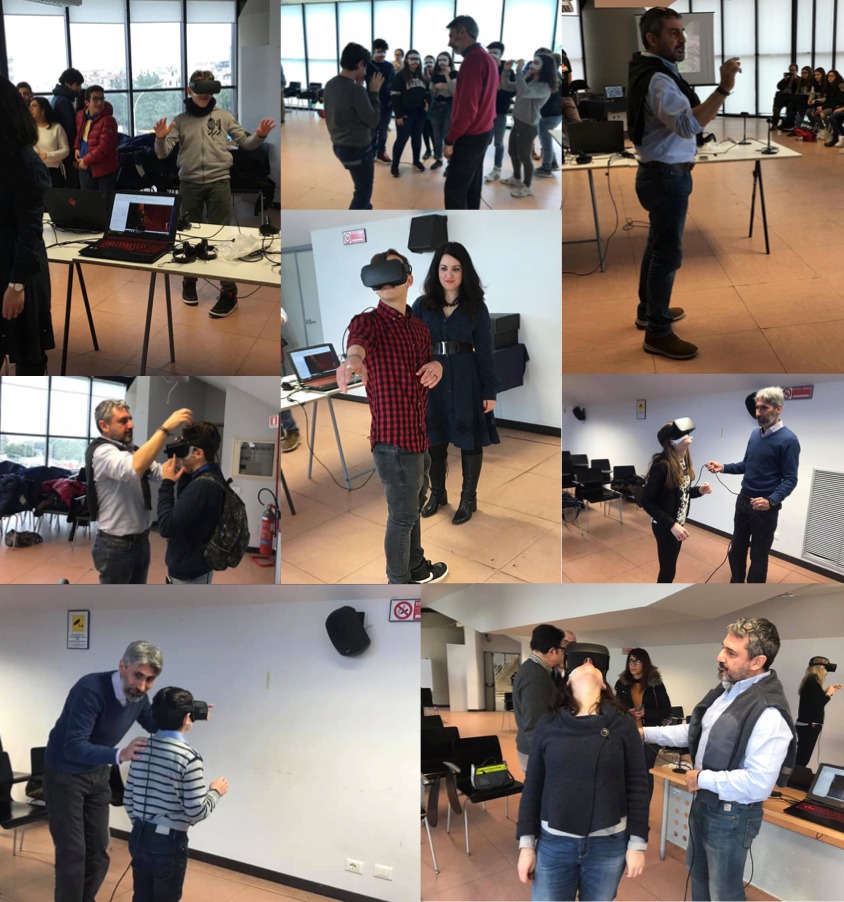|
|
3-DIMENSIONAL MODELING OF ASTROPHYSICAL PHENOMENA
IN VIRTUAL REALITY (3DMAP-VR)
Fully 3D MHD simulations of astrophysical phenomena represent a
challenge in standard data visualization for scientific purposes, for
the amount of processed data and the wealth of scientific information
they contain. However, virtual reality (VR) hardware and software are
now commonly used in different fields for public outreach and education
with excellent feedback. To this end, YouTube and online multimedia
digital stores have several high-impact VR titles in the Astrophysics
and Space Science categories of their catalogs. The routine, scientific
use of VR environments, however, is still in its infancy.
In the first half of 2019, we launched 3DMAP-VR (3-Dimensional Modeling
of Astrophysical Phenomena in Virtual Reality), a tool for visualizing 3D
MHD models of astrophysical simulations, using VR equipment. The workflow
combines: 1) accurate 3D HD/MHD simulations performed for scientific
purposes using the FLASH code or the PLUTO code in HPC facilities, 2)
the Paraview software (developed by Kitware Inc and distributed under
a permissive BSD license) to realize the scenes and quickly have a VR
representation of the model. The tool is used to analyze the numerical
results in an immersive fashion, integrating the traditional screen
displays. The models account for all the relevant physical processes
in astrophysical phenomena: gravity, magnetic-field-oriented thermal
conduction, energy losses due to radiation, gas viscosity, deviations from
proton-electron temperature equilibration, deviations from the ionization
equilibrium, cosmic rays acceleration, etc. The 3D representations of
the models are realized using a mixed technique consisting of multilayer
isodensity surfaces with different opacities.

Involved people
| Bocchino Fabrizio |
fabrizio.bocchino AT inaf.it |
INAF/OAPa |
| Daricello Laura |
laura.daricello AT inaf.it |
INAF/OAPa |
| Leonardi Laura |
laura.leonardi AT inaf.it |
INAF/OAPa |
| Miceli Marco |
marco.miceli AT unipa.it |
Universita' di Palermo, INAF/OAPa |
| Orlando Salvatore |
salvatore.orlando AT inaf.it |
INAF/OAPa |
| Pillitteri Ignazio |
ignazio.pillitteri AT inaf.it |
INAF/OAPa |
Sketchfab
Sketchfab is one of the largest open access platforms for immersive
and interactive 3D models. We immediately recognized its enormous
potential for dissemination and communication activities. We expect
excellent synergy between our 3DMAP-VR project and Sketchfab to
promote a wide dissemination of results for both scientific and public
outreach purposes. To this end, we started a Sketchfab collection, "Universe
in hands", which gathers different models of astrophysical
objects and phenomena developed by our team for scientific
purposes and published in international scientific journals
and magazines. A Science Spotlight published by Sketchfab on
the activity of INAF/OAPA can be found at the following link.
Universe in
hands
by Salvatore
Orlando
on Sketchfab
As an example of a model from this collection, the following describes
the structure of Cassiopeia A, the outcome of the catastrophic explosion
(a supernova) of a massive star at the end of its life about 340 years
ago. The model shows the highly inhomogeneous distribution of stellar
debris after the explosion; the different colors mark different chemical
elements. The study of the structure of supernova remnants is fundamental
in astrophysics because the remnants encode crucial information about
the physical processes associated with the supernova engine.
Supernova Remnant Cassiopeia A
by Salvatore Orlando
on Sketchfab
Another example is the following model which describes the aftermath of
a nova, a thermonuclear explosion occurring on the surface of a white
dwarf star that is accumulating material from a companion red supergiant.
The model shows the blast wave that expands through the inhomogeneous
circumstellar medium 17 days after the explosion and the distribution
of the ejected material, expanding with supersonic velocity after the
explosion. These studies are important because the material ejected
after the explosion gives us the unique opportunity to investigate the
chemical composition of the outermost layers of the white dwarf, and
the interaction of the blast wave with the surrounding medium allows us
to explore the structure and density distribution of the circumstellar
medium. All these pieces of information concur to unveil the latest
stages of stellar evolution.
The animation below shows the evolution of the magnetic field lines around
a hot Jupiter while orbiting around its parent star. The simulation is
based on a MHD model describing the so-called star-planet interaction
(SPI) and applied to the case of HD 189733. The result is that the lines
of the magnetic field around the planet are stretched along the direction
of the orbital motion of the planet. This is a consequence of the gas
evaporating from the planet itself due to the intense irradiation from
the star. These simulations are important for the evolution of close-in
planets around solar analogues.
The example below shows a low-mass infant star during the phase
of accretion of mass. The protostar (at the center of the scene) is
analogous to our star, the Sun, when it was formed about 5 billion years
ago. The protostar is surrounded by a circumstellar disk from which the
star accretes matter. An intense activity due to sudden releases of
energy (flares) near the disk gradually forms an extended hot corona
(temperature of several million degrees) above the disk that emits in
the X-ray band. The flares perturb the disk and trigger the accretion of
mass onto the protostar. These studies are important to investigate how
star systems similar to our solar system form and, therefore, to unravel
the physical conditions that could lead to the formation of habitable
planets and, ultimately, of life.
| | |